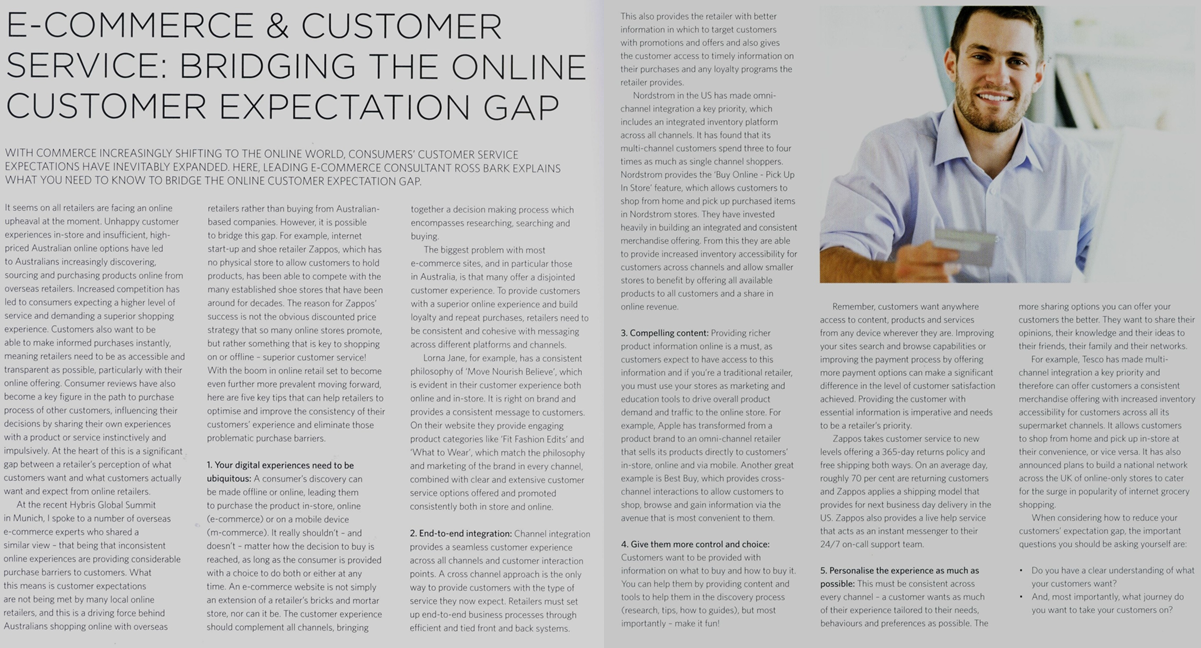Ross Bark recently talked to Svetlana Zolotareva about Enterprise Wide‘s experience in advancing #ecommerce customer experience and the fantastic success story of Gallagher, a global leader in providing animal management, security and fuel solutions.
Category Archives: eCommerce Articles
A great B2B online buying experience is key to buyer retention and growth
For 67% of buyers, the ability to order through a supplier’s website is considered either very important (38%) or extremely important (29%) according to a recent survey by UPS on B2B purchasing insights, which looked at the behaviours, preferences and perceptions of industrial supplier performance.
The UPS B2B Purchasing Insights Study, conducted in partnership with research firm TNS, looked at both the current and intended purchase behaviours of buyers across the purchasing process.
Buyers reported that the majority of their suppliers have websites that offer online ordering and 34% said they have gone outside of their existing supply base to make an online purchase with a new vendor.
Integration is also an important requirement, with buyer’s highly ranking greater integration of a seller’s systems and processes – inventory, shipping and returns – in order to provide a more competitive and satisfying customer experience.
For example, data suggests that offering real-time product availability, negotiated pricing and shipping costs into the online purchase experience may help to fill a need for many buyers.
63% of industrial supplies buyers purchase through websites, whether directly from suppliers or through a third-party provider, but many still use phone, fax and placing orders through sales representatives or emails.
Importantly, those suppliers that can differentiate their ordering process with enhanced speed, ease and convenience are at a significant advantage.
Despite this, many suppliers are struggling to provide a seamless and easy ordering system for their customers with the complexity of B2B purchasing, such as negotiated pricing and multiple payment policies, providing inhibitors to new technology investment.
B2B Online buyers value website features that offer more insight into product information details, order costs and status.
Among buyers who purchase through suppliers’ websites, the ability to know shipping costs before ordering was one of the most mentioned benefits.
Other key benefits include:
– Real-time product availability
– Purchase history and delivery dates.
– Improved visibility into real-time product information and availability
In Australia and NZ, many suppliers are considering investments in improved B2B commerce platforms that can provide a fully integrated buying experience for their customers.
And it is clear that a valuable competitive advantage comes from those that can provide their customers with the best online buying experience by delivering the buying channels their customers want combined with the right business processes.
For more information: www.ciber.com.au
Investing in the right online platform
Salmat Digital eCommerce Principal Consultant Ross Bark told RetailBiz retailers should be asking themselves two key questions when it comes to reassessing their online business, particularly at a time where brand loyalty does not exist.
“Two key points retailers should ask themselves are: ‘do you have an understanding of who are your customers?’ and ‘what journey do you want to take the customer on?’ If retailers can answer those questions and have the technology to help them they certainly will be able to lead in the space and we’re seeing a few examples of that already,” he said.
“I think the reality comes down to making sure they invest in the right platform that can support the business in its growth journey, which is what I think that has been really lacking here. That makes it difficult for retailers to keep up because then they’re always going to be playing catch up.”
Read More: http://www.retailbiz.com.au/2013/12/05/article/Investing-in-the-right-online-platform/KKDJNDHXIQ
SMH – Loose lips on social media a marketer’s delight
Local Measure has assisted Gelatissmo in connecting with customers,  gathering snapshots of customer opinions, and identifying influential customers.
gathering snapshots of customer opinions, and identifying influential customers.
Salmat Digital’s principal consultant Ross Bark says Gelatissimo found fans by searching through publicly posted Instagram pictures tagged with #gelatissimo, and then used Instagram’s geo-tagging capability to determine where the images were taken to help provide customers with improved customer service.
Inside Retail Article – ‘Twas the shopping night before Christmas
Ten years ago, the mad festive rush featured crowds of shoppers flocking to shopping centres on Christmas Eve.
While the crowds certainly still flock, Christmas shopping has become a little more sophisticated in the last decade.
Ross Bark, Principal Consultant of e-commerce at Salmat Digital, says Christmas shoppers are reflecting the online boom.
“Christmas shoppers’ instore behaviour has changed significantly in the last 10 years, with shoppers much more convenience focused,” he says.
“Consumers are increasingly using physical stores for research purposes before buying the same products online, either because of lower prices or for the convenience of home delivery.”
Read More: http://www.insideretail.com.au/2013/11/26/twas-shopping-night-christmas/
E-Commerce & Customer Service: Bridging the Online Customer Expectation Gap
Tips on bridging the online customer expectation gap in My Business magazine.
DJs praised for ‘ballsy’ vid, despite lack of mobile function – B&T Magazine

DJ’s shoppable video screen shot
David Jones’ foray into shoppable video has been hailed for its “ballsiness”, but blasted for not being clickable on mobile devices favoured by its youth target market.
Ross Bark, principal e-commerce consultant at Salmat agreed the video looked good, but said it needed to have a listing of products overlaying the video, citing examples from ASOS and Barney’s in New York.
“This is the key – consumers want a shopping experience which has smooth interactions across all channels, which provides the best possible convenience – and this is the biggest challenge,” he added.
Read More: http://www.bandt.com.au/news/digital/djs-praised-for-ballsy-shopping-vid-despite-lack-o
DJs gets competitive with e-tail updates – B&T Magazine
David Jones’ new shoppable videos have digital experts excited, but the retailer’s latest round of ecommerce developments needed to focus more on online customer service they argue.
Ross Bark, e-commerce principal consultant at Salmat Digital, said the videos will make it much easier for consumers to shop the looks.
Read More: http://www.bandt.com.au/news/digital/djs-gets-competitive-with-e-tail-updates …
Are retailers doing enough to capture the mobile market?
Ross Bark, Principal Consultant eCommerce looks into who capitalises on mobile’s momentum in the Dynamic Business magazine.
The proportion of Australians transacting on mobile devices has seen strong growth over the past 2 years, with the amount of online retail transactions carried out on mobile devices rising to 32 per cent.[i]
In addition to making purchases, mobile devices are also being used to compare prices with other retailers (63 per cent), look for discount vouchers online (42 per cent) and to find product information or other options on a different retailer’s website (34 per cent).
Mobile’s momentum has continued to accelerate in 2013 with more than 1 million apps now available, more than 150 million tablets sold, and more than 1 billion smartphones in consumers’ pockets globally.[ii]
To capitalise on this momentum, retailers need to consider whether a specially created app or mobile optimised website is a worthwhile investment for their business. The value that a mobile strategy can provide to a retailer will depend on the products being sold, the market and the customer demographic.
London department store Harrods boosted its global sales through its new mobile-optimised site which offers international transactions and shipping options. The new site attracts consumers by offering a convenient way to shop on the go, and by opening up sales to a new audience of customers abroad.
The key to a successful mobile strategy is offering customers an enhanced experience that is unique to mobile, which is easy to use and meets their needs.
A good example of this is Italian fashion house Gucci which has quadrupled mobile revenue and experienced a 70 per cent growth in mobile conversion since the launch of its optimised Web site for iOS and Android devices.
The site also contains a store locator that uses a smartphone’s GPS to find nearby retail stores and link customers with local fashion events. In optimising their mobile site, Gucci has focused on the product within the site with the intention of providing a shopping experience that feels just as high-end as shopping on a desktop computer or in the store.
Retailers should also consider how a mobile offering will assist in acquiring additional loyalty members. Walgreens in the US designed its mobile site as a tool for building its loyalty program, and has already experienced an increase of over 72 million loyalty members in the past nine months by enabling customers to earn points across all of the Walgreen’s channels – from in-store, online or from a mobile device.
A unique component of Walgreen’s loyalty program was the integration of a health and fitness program called Steps, with app users able to connect their walking and running activity to earn reward points as well as exchange ideas with the brand’s program.
Loyalty programs should be a key consideration when developing a mobile strategy, giving retailers leverage to differentiate themselves from ecommerce giants such as Amazon and eBay which compete on price, by offering convenience and brand loyalty.
Mobile has changed the customer experience in three ways: immediacy, simplicity and context.
When consumers use mobile, they want anytime, anywhere access to information, they want simple tasks and they expect relevant solutions.
While there is evidence that mobile devices are changing how people shop, the shopping process that consumers follow remains largely unchanged.
Nine out of 10 consumers visit online sites largely for convenience; the challenge for businesses is to meet the expectations of consumers online while concurrently influencing their decision to purchase.
When implementing a mobile strategy retailers often struggle to migrate the online experience beyond the desktop to one that offers consistent experiences across all screens.
This is mainly due to their inability to successfully engage their mobile strategy as a defined channel rather than a subset of their desktop site.
Mobile shouldn’t be seen as a secondary online channel to desktop, but as an equally vital channel for boosting sales conversion and as a key tool for researching before buying.
Consumers are increasingly task-oriented in their use of mobile devices. As a result, they also expect simplicity.
Salmat Digital recently launched a specially designed mobile site for an apparel retailer client, which provides their customers with a substantially improved mobile shopping experience that is consistent with their web user experience.
Since the launch they have seen a 180 per cent increase in mobile sales and a conversion rate higher than 2 per cent.
Retailers need to begin thinking about mobile as a seamless part of a broader shopping experience to fully harness the power of mobile. And clearly if retailers do not engage consumers on mobile, they risk becoming out-dated and overrun by their competitors.
The key strategy to achieve this is to focus on implementing a centralised product information management (PIM) system, providing the power for a retailer to push the right content to the right channels at the right time. This allows a seamless and consistent user experience across web and mobile.
Streamlining processes around a centralised PIM solution and ensuring tight integration with ecommerce platforms will help ensure retailers get the right product to the right place at the right time.
Clever geeks follow your data trail to find out everything about you
E-commerce guru Ross Bark, of Salmat Digital, said by merging information gathered from social media sites with existing databases, marketers were hoping to predict real-time purchasing behaviour.




